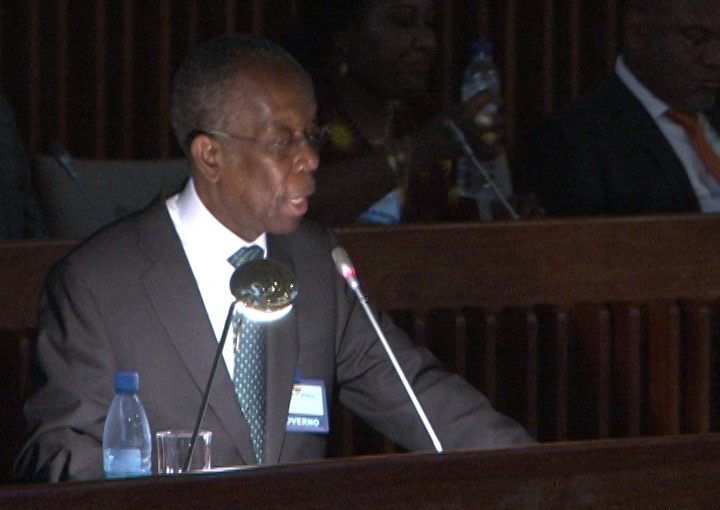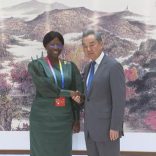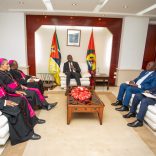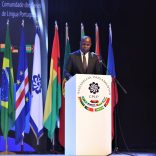China: Wang Yi meets with Mozambican foreign minister - Watch
Finance Minister denies Renamo claims on Defence spending – Mozambique

TVM / Minister Maleiane addressing Parliament
Mozambican Finance Minister Adriano Maleiane on Thursday categorically denied claims by the main opposition party, the rebel movement Renamo, that the budget for 2017 is dominated by the defence and security sectors.
Speaking on the second day of the debate on the 2017 plan and budget in the country’s parliament, the Assembly of the Republic, Maleiane said that, in percentage terms, defence and security receives a smaller share of the 2017 budget than of this year’s budget – the amount spent on all defence and security (the defence and interior ministers, the armed forces, the police and the security service) has fallen from 7.3 to 6.6 per cent of total public expenditure.
This, he pointed out, was considerably less than the 10.1 per cent allocated to health. “We would like to spend more on health and we would like to spend more on defence”, said Maleiane.
Year after year Renamo has claimed that the state budget prioritises, the army, the police, and the security service (SISE), and year after year the government patiently explains that this is not true. Either Renamo deputies are still unable to read the budget, or they are deliberately lying about it.
This year the independent newssheet “Mediafax” repeated these claims. Its front page headline on Thursday read “Repression and security remain at the top”. Although “Mediafax” is normally a well-informed and reliable paper, it fell into the trap of not reading the entire budget, and so presenting a distorted picture.
The state budget contains both a budget for running costs and a capital budget. It is also divided into central and provincial levels, all of which must be considered. SISE, the armed forces and the President’s Office all have their budgets centralised, but education, health, agriculture and public works are decentralized, with most of their expenditure allocated to the provinces. Renamo habitually ignores the provincial budgets, and this year so did “Mediafax”.
“Mediafax” confidently stated that the SISE budget is 1.8 billion meticais (about 24.9 million US dollars), while only 534 million meticais is allocated to education, and 112 million to agriculture and food security.
All of these figures are accurate, but refer only to the running costs budget at central level. When the capital budget is taken into consideration, and all the provincial expenditure, the full education budget turns out to be 48.287 billion meticais, and the agriculture budget is 18.216 billion meticais.
The SISE capital budget is 91.6 million meticais and there are no SISE provincial budgets. So the total SISE allocation is just short of 1.9 billion meticais. The budgetary allocation for education is thus 25 times as large as that for SISE.
Facts and figures, however, did not stop Renamo from saying the opposite throughout the debate. The Renamo group in the Assembly’s commission on public administration claimed the budget “prioritises non productive sectors such as the Presidency, SISE and repressive sectors”, and neglects vital sectors “such as education, health, justice and security for Mozambicans”.
Deputy Jose Samo Gudo claimed that SISE, the Interior Ministry and the Presidency were allotted huge sums, while his colleague Eulalia Oliveira claimed “defence and security have enormous resources to continue the war, to kill, torture and silence those who are against the regime”.
Even after Maleiane had given the true figure for defence and security spending, Renamo deputies continued with fantastic claims. Carlos Maiela claimed that money was going to the defence ministry “to the detriment of agriculture”. The correct figure for the Defence Ministry is 592 million – spending on agriculture is 30 times that sum.
Antonio Timba claimed that the allocation to the President’s office is twice as large as the allocation to education. In fact, the total allocation to the Presidency is 1.14 billion meticais, which is only 2.4 per cent of the allocation to education.
Maleiane said that the great bulk of the spending in the 2017 budget is for economic and social sectors – 68.8 per cent of total public expenditure.
This breaks down as follows: Education, 23 per cent; Health 10.1 per cent; Agriculture and rural development, 8.7 per cent; Roads, 8.5 per cent; Water supply and public works, 7.7 per cent; Transport and communication, 4.3 per cent; Social welfare and labour, 3.6 per cent; Judicial system, 1.5 per cent; Mineral resources and energy, 1.4 per cent.













Leave a Reply
Be the First to Comment!
You must be logged in to post a comment.
You must be logged in to post a comment.